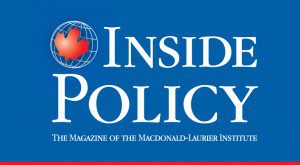 With a successful state dinner and a positive tone, Justin Trudeau seems more like Laurier than Trudeau Sr. when it comes to Canada’s bilateral relationship with the US, writes Sean Speer. His meeting with Barack Obama was the new PM’s best performance to date
With a successful state dinner and a positive tone, Justin Trudeau seems more like Laurier than Trudeau Sr. when it comes to Canada’s bilateral relationship with the US, writes Sean Speer. His meeting with Barack Obama was the new PM’s best performance to date
By Sean Speer, April 6, 2016
Justin Trudeau’s predecessors offered two paths to choose from when he articulated his vision for Canada-United States relations last June less than six months prior to the 2015 federal election. He could pursue a path of confident engagement that recognized the continental pull of economic and cultural forces or he could steer and prod these dynamic pressures in a new direction that sought to reduce Canada’s dependence on the United States.
The first option is best represented by Sir Wilfrid Laurier’s self-confident leadership. The second is personified by Pierre Elliott Trudeau’s economic nationalism. These two tensions – economic interdependence and a defensive nationalism – have been at the heart of the Canada-US relationship. The current Prime Minister Trudeau has opted to follow Laurier’s path rather than his father’s.
Canada’s geographic proximity to the United States and the economic and security issues that stem from our closeness have been a shaping force in Canadian politics since the beginning. Confederation was in large part a response to the abrogation of continental free trade by the United States in 1866. If we were no longer to have preferential access to the US, should we not at least have free trade among the future provinces? The answer was in the affirmative and Sir John A. Macdonald and the other founders went about the exercise of nation building.
 It would be far from the last time that the Canada-US relationship loomed over our politics. The elections of 1911 and 1988, for instance, were watershed moments in the evolution of Canadian public policy and our economic relationship with the United States. Prime Minister Laurier did not lose the 1911 election. It just took 77 years to count the ballots.
It would be far from the last time that the Canada-US relationship loomed over our politics. The elections of 1911 and 1988, for instance, were watershed moments in the evolution of Canadian public policy and our economic relationship with the United States. Prime Minister Laurier did not lose the 1911 election. It just took 77 years to count the ballots.
This formulation obviously requires some reductionism. The ensuing three-quarters of a century involved a shift in Canada’s trade and security orientation from the United Kingdom to the United States and the institutionalization of the Canada-US relationship in a series of agreements, partnerships, and joint operational and strategic engagements such as the Permanent Joint Board on Defence and North American Aerospace Defence Command (NORAD).
The inexorable trend towards greater integration was larger than one person or one relationship.
This build-up of continental institutions often occurred at the administrative or bureaucratic level. It mattered little who was serving as prime minister and president. Sometimes these developments occurred even in spite of personal irritants between the two leaders. President Johnson was chastising Prime Minister Pearson because he had “pissed on my [Johnson’s] rug” at roughly the same time that the Columbia River Treaty and the Auto-Pact were negotiated.
The inexorable trend towards greater integration was larger than one person or one relationship. The post-World War II era was marked by slow yet steady economic integration. Some voices (including socialists and conservatives) would decry this trend along the way. Others (including Prime Minister Pierre Trudeau) sought to manipulate Canadian trade patterns in another direction. But market forces continued unabated.
Pierre Trudeau’s defensive nationalism was evidenced by the enactment of the Foreign Investment Review Act which sought to limit foreign ownership – namely, US investment – in the Canadian economy, the Third Option Policy which aimed to reorient Canadian investment and trade patterns away from the US market, and the creation of state-owned enterprises and institutions (such as Petro-Canada) to assert greater domestic control over the economy. These efforts were motivated in large part by a defensive posture vis-à-vis the United States. Mr. Trudeau was attempting to reverse the trend toward closer integration that had accelerated in the post-war era. As two Canadian historians have noted: “it is no small irony, that Trudeau, the visceral opponent of nationalism in Quebec, the committed liberal, the promoter and defender of individual rights, came to embody Canadian nationalism in economic and cultural policy.”
This type of statist tinkering was in hindsight a fool’s errand. The integration of Canadian industry along continental lines meant that no number of trade missions to Asia was going to fundamentally shift the country’s economic orientation. It proved to be an exercise in vanity and the false confidence in the power of state action. It also went great lengths to inadvertently confirm that nationalistic concerns about Canada’s economic and political autonomy were overstated. This formative period proved that greater economic integration did not put the Canadian political project at risk as Conservatives had claimed in the 1911 election.
Whatever his motivations it is clear that Justin Trudeau’s US policy reflects the Laurier tradition of confident bilateral engagement built on shared values and interests.
Counterfactual apprehensions about the political risks to Canadian sovereignty that stemmed from economic integration were thus, by and large, disproven by 1988. John Turner’s use of the nationalist arguments from 77 years earlier was ineffectual. The result was the first bilateral free trade agreement in more than 100 years and a massive furtherance of the economic relationship. Much had happened in the intervening time but the path had been set by Laurier. It is difficult to overstate the consequences.
Consider that that two-way trade totalled $2.4 billion every day or $1.6 million every minute in 2014. About 77 percent of Canadian exports are destined to the US market. The second largest export market is China which accounts for a paltry 3.7 percent. Exports to the US are nearly one quarter of Canada’s total economic activity. And that is to say nothing of our deep defence and security links or cooperation on issues such as climate change, boundary waters, student exchanges and research and development.
It is no surprise therefore that current Prime Minister Trudeau has placed such an emphasis on Canada-US relations. It is one issue where he seems to side with Laurier (his political idol and second favourite prime minister) rather than his father who often seemed suspicious and contemptuous of the United States.
The current prime minister does not share these misgivings. It may be a generational distinction. It may also be that Mr. Trudeau has a better appreciation of Canada’s history than his famous father. Whatever his motivations it is clear that Justin Trudeau’s US policy reflects the Laurier tradition of confident bilateral engagement built on shared values and interests.
His pre-election speech on Canada-US relations in June 2015 was the first expression of his policy. There were the usual political critiques of the governing party and platitudes about doing a better job representing Canada’s interests. But at its core Mr. Trudeau’s speech was a rejection of superficial anti-Americanism (which at times had found a home in the modern Liberal Party) and acceptance of the long-standing trend towards continentalism. He described the Canada-US relationship as “definitional” and dismissed the false choice between “a strong national identity and an economic interdependence.” His remarks were, in a phrase, prime ministerial. It was an important step on his path to the political credibility and ultimately his major electoral victory in October 2015.
Fast forward less than 5 months and Mr. Trudeau found himself in Washington for the first state dinner for a Canadian prime minister in nearly 20 years and the first opportunity to show that his vision for bilateral engagement is the right one to advance Canada’s interests in the US capital.
It is hard to contest that it was not a successful bilateral visit. Prime Minister Trudeau and President Obama have, by all accounts, developed a strong personal relationship and it would appear that this has extended to the staff level where there are already personal connections that come from traveling in similar progressive circles. Media speculation is that President Obama and his team have come to see Mr. Trudeau and his advisers as their “heir” with respect to present-day progressivism.
As for deliverables, the meeting’s primary output may have been goodwill rather than concrete progress on key bilateral issues. This is not a criticism of Mr. Trudeau. There were real limitations to new developments due to the ongoing friction between President Obama and the Republican-controlled Congress and the president’s increasingly “lame duck” status. Still there were some positive noises about softwood lumber (an update from ministers in 100 days), proceeding with a new pre-clearance regime for goods and travellers, new harmonized methane emissions regulations, and greater cooperation in the Arctic. It was a positive start especially since the Trudeau government was only officially sworn in on December 4.
It was, in short, the prime minister’s best performance to date and a signal to his detractors that he is up to the job.
Prime Minister Trudeau was a confident participant over the course of the visit. He struck the right tone between economic partner, defence and security ally, and friend, and refrained from the anti-American sophistry that tends to play well in the Canadian market. He spoke about shared values and interests and the importance of the Canada-US relationship for workers, families, and communities on both sides of the border. He recognized that Canada’s interests lie in effective engagement rather than moralizing sniping or differentiation for its own sake. He even largely avoided commenting on Donald Trump’s candidacy even though there is little in the Republican frontrunner’s message or programme with which he would find resonance. It was, in short, the prime minister’s best performance to date and a signal to his detractors that he is up to the job.
Now there remain outstanding bilateral challenges. The softwood lumber agreement will expire in less than a year and, without a new deal or an extension, Canadian producers are bound to face major impediments to the US market. An election of Mr. Trump will likely change the dynamic between prime minister and president. It will be less natural and more difficult than it has been thus far with President Obama. Ongoing security concerns will risk a thickening of the border for Canadian exporters. And the emergence of new issues – including ones that we cannot presently anticipate – are bound to test the relationship. No one can effectively judge how a Trump presidency, for instance, will affect our shared issues, including the North America Free Trade Agreement.
But irrespective of what irritants surface, Mr. Trudeau and Canada should be well-served by the prime minister’s Laurier-like approach. Real leadership involves confident engagement with the United States rather than empty nationalism. Justin Trudeau’s first trip to Washington passed this test.
Sean Speer is a Senior Fellow at the Macdonald-Laurier Institute.





